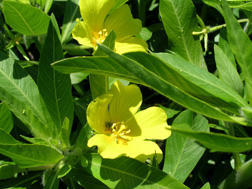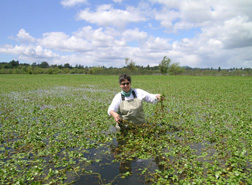Squelching Water Primrose
|
|
With its beautiful, bright-yellow flowers, water primrose might seem like the perfect aquatic plant to enhance a serene backyard pond.
But if it’s a South American water primrose that you have in mind—Ludwigia hexapetala from Uruguay, for instance—don’t be tempted. This species and other invasive water primroses are weeds that can crowd out native plants.
In South America, both the shrub-forming and small-statured water primrose plants are well-behaved members of watery natural ecosystems. In the United States, however, these aggressive, nonnative Ludwigia plants infest ponds, lakes, streams, rivers, canals, and reservoirs along both East and West coasts, and at some inland sites, as well.
Now, ARS researchers in the United States and Argentina are targeting the alien water primrose species in a new effort to keep people, pets, livestock, and farmland safe from the threats these plants harbor.
Along with providing a haven for mosquitoes that could carry West Nile virus, the plants pose a hazard to growers because the dense mats that the weed forms can easily clog water channels, causing overflows in adjacent fields, orchards, and vineyards.
|
|
But insects that attack unwanted water primrose species may help stop the plant’s spread. Ray Carruthers and Lars Anderson, with ARS in California; Cristina Hernández and Willie Cabrera Walsh in Argentina; and colleague Robinson Pitelli in Brazil pinpointed some promising candidate insects in a 2005 trek through wet and wild regions of Argentina and Brazil. The intent of their journeys? Find critters that dine on invader water primrose species—but not other plants.
The scientists’ work confirmed ARS studies in South America, completed in the 1970s. That earlier work, put on hold for studies on more threatening weeds, had also spotlighted the potential of a beetle with the tongue-twisting name of Lysathia flavipes and several similarly hard-to-pronounce weevils—Ochetina bruchi, Auleutes bosqi, and some Onychylis and Tyloderma species. That’s according to Juan Briano, who heads ARS’s South American Biological Control Laboratory in Hurlingham (near Buenos Aires), where Hernández and Cabrera Walsh are based.
Hernández leads the Hurlingham quest to identify some of the other primrose-eating insects that the scientists brought back from their expedition. And she’s heading the exacting “host-specificity” testing that determines whether the insects will attack water primrose exclusively. This research yields the all-important guarantee that these candidate biological control agents, if brought into the United States to tackle water primrose, won’t wander from an infested pond to have a taste of something a little different—someone’s prize rose bushes, for instance.
Meanwhile, thousands of miles away in Davis, California, ARS ecologist Brenda Grewell is hunting for answers to tough questions about the little-known life cycle of water primrose. Her aim: find times of high natural vulnerability. These could become critical windows of opportunity for clobbering the plant. She’ll determine, in other studies, the best strategies for reestablishing the native vegetation that water primrose pushed out and the best ways to make sure that—once primrose is gone—it stays away.
From these and other meticulous studies underway in North and South America, science-based strategies for bringing water primrose under control are likely to blossom soon.—By Marcia Wood, Agricultural Research Service Information Staff.
This research is part of Crop Protection and Quarantine, an ARS National Program (#304) described on the World Wide Web at www.nps.ars.usda.gov.
To reach scientists mentioned in this article, contact Marcia Wood, USDA-ARS Information Staff, 5601 Sunnyside Ave., Beltsville, MD 20705-5129; phone (301) 504-1662, fax (301) 504-1486.
"Squelching Water Primrose" was published in the May 2006 issue of Agricultural Research magazine.








